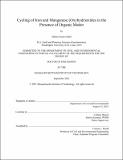| dc.contributor.advisor | Colleen Hansel. | |
| dc.contributor.author | Gadol, Hayley Jayne | |
| dc.date.accessioned | 2022-01-12T16:01:42Z | |
| dc.date.available | 2022-01-12T16:01:42Z | |
| dc.date.copyright | 2021 | |
| dc.date.issued | 2021 | |
| dc.identifier.uri | https://hdl.handle.net/1721.1/138892 | |
| dc.description | Thesis: Ph. D., Massachusetts Institute of Technology, Department of Civil and Environmental Engineering, September, 2021 | |
| dc.description | Cataloged from the official PDF of thesis. | |
| dc.description | Includes bibliographical references (pages 127-145). | |
| dc.description.abstract | Iron (Fe) and manganese (Mn) (oxyhydr)oxides (or “oxides”) are found in many different environments and are strong sorbents of nutrients and contaminants. Therefore, understanding their cycling has implications for many other biogeochemical cycles. This thesis aims to improve our understanding of microbial and photochemical processes governing Fe/Mn cycling and how the specific mineralogy of Fe/Mn oxides influences these processes. In Chapter 1, we determine the influence of iron oxide mineralogy on methanogenesis using sediment from Upper Mystic Lake (Arlington, MA) as an inoculum in acetate-fed bioreactors. We find that the poorly crystalline mineral ferrihydrite delays the onset of methanogenesis relative to controls while more well crystalline hematite and goethite do not. We also find that only ferrihydrite-amended microbial communities differ considerably from controls based on 16S-rRNA sequencing data. These ferrihydrite-amended communities continue to diverge from other experiments over time despite a convergence in methane production. In Chapter 2, we characterize Mn cycling in Siders Pond (Cape Cod, MA). We find Mn oxides consistently present in the surface waters, and concentrations reach a maximum in late summer before declining substantially in November. Incubation experiments are used to determine Mn cycling in Siders Pond is mediated mainly by the balance between microbial Mn oxidation and photoreduction. In Chapter 3, we further explore Mn oxide photoreduction in the presence of organic matter. We find that photoreduction apparent quantum yields (AQYs) of 𝛿-MnO₂ in humic acid solutions decrease with wavelength regardless of pH, and that AQYs in the UV-A range are highest at pH 5, while AQYs in the 450- 550 nm range are highest at pH 9. Additionally, we see no measurable photoreduction of triclinic birnessite in similar experiments. We also show that AQYs of 𝛿-MnO₂ photoreduction in natural filtered waters from three water bodies in Cape Cod, MA (Siders Pond, Oyster Pond, and seawater) are similar. We use this AQY response with wavelength to calculate water column reduction rates in Siders Pond and determine that the visible range from 400-450 nm is the most important for Mn photoreduction. This work improves our understanding of Fe and Mn oxide cycling in natural environments. | en_US |
| dc.description.statementofresponsibility | by Hayley Jayne Gadol. | |
| dc.format.extent | 125 pages | |
| dc.language.iso | en_US | en_US |
| dc.publisher | Massachusetts Institute of Technology | en_US |
| dc.rights | MIT theses may be protected by copyright. Please reuse MIT thesis content according to the MIT Libraries Permissions Policy, which is available through the URL provided. | |
| dc.rights.uri | http://dspace.mit.edu/handle/1721.1/7582 | |
| dc.subject | Civil and Environmental Engineering. | |
| dc.title | Cycling of Iron and Manganese (Oxyhydr)oxides in the Presence of Organic Matter | en_US |
| dc.type | Thesis | en_US |
| dc.description.degree | Ph.D. | |
| dc.contributor.department | Massachusetts Institute of Technology. Department of Civil and Environmental Engineering | |
| dc.description.collection | Ph.D. Massachusetts Institute of Technology, Department of Civil and Environmental Engineering | |
| mit.thesis.degree | Doctoral | |
| mit.thesis.department | CivEng | |
